
A reported rise in the overall household savings rate isn’t going to protect against the economic and financial risk posed by the large number of mortgage renewals occurring over the next couple of years, cautions CIBC World Markets Inc.
In a new report, the bank’s economists note that the household savings rate rose to 7.2% in the second quarter, up from 6.7% in the previous quarter, and now sits well above the 2% rate that prevailed in 2019 before the pandemic hit.
Despite the apparent increase in savings, households remain vulnerable to the forthcoming wave of mortgages renewing at higher rates over the next couple of years, the report suggested.
For one, the headline savings rate is not necessarily a good measure of how much households are actually saving, it said.
Complications, including how consumer spending is captured in national economic data, how that consumption is financed and the timing of data reporting, can cloud the level of household savings.
As a result, “any attempt to calculate accumulated savings from the quarterly national accounts data should be done with caution,” the report said.
Additionally, excess savings that have accumulated “may not be held by those households most at risk from upcoming mortgage renewals,” it noted.
For instance, much of the excess savings appears to be in Quebec, whereas the mortgage renewal pressures are expected to be most acute in Ontario and British Columbia, which saw the largest growth in mortgages during the pandemic, and those mortgages “will be up for renewal in the coming years,” it said.
Additionally, the data suggest that households without mortgages have accounted for much of the increased savings, the report said.
“By income group, the highest and lowest have driven most of the increase in the savings rate,” the report said. “The lowest quintile will include households more likely to be renters, or potentially retirees. Meanwhile, the highest quintile, despite having quite large mortgages on average, are unlikely to be those most stretched by payments relative to their income.”
Conversely, the households that “took on proportionally more mortgage debt during the pandemic years” have seen savings rates decline relative to pre-pandemic levels, it noted.
“The higher household savings rate seen post-pandemic appears to be no saving grace for homeowners with upcoming mortgage renewals. Not only may the true amount of excess savings in the economy be less than implied by this simple measure, but the distribution appears to be tilted toward the least vulnerable households,” the report said.
It warned that the “wall of mortgages coming up for renewal next year and in 2026 remains a threat, and the Bank of Canada may have to take interest rates slightly below neutral to mitigate the risk at that time.”
The one bright spot for the economy overall is that, as rates come down, the “households that have been incentivized to save more and take on less debt may up their spending and help drive an acceleration in household consumption and residential investment.”